Construction Purchase Orders: A Contractor’s Guide to Project Owner’s
-
Sapna
- May 10, 2024
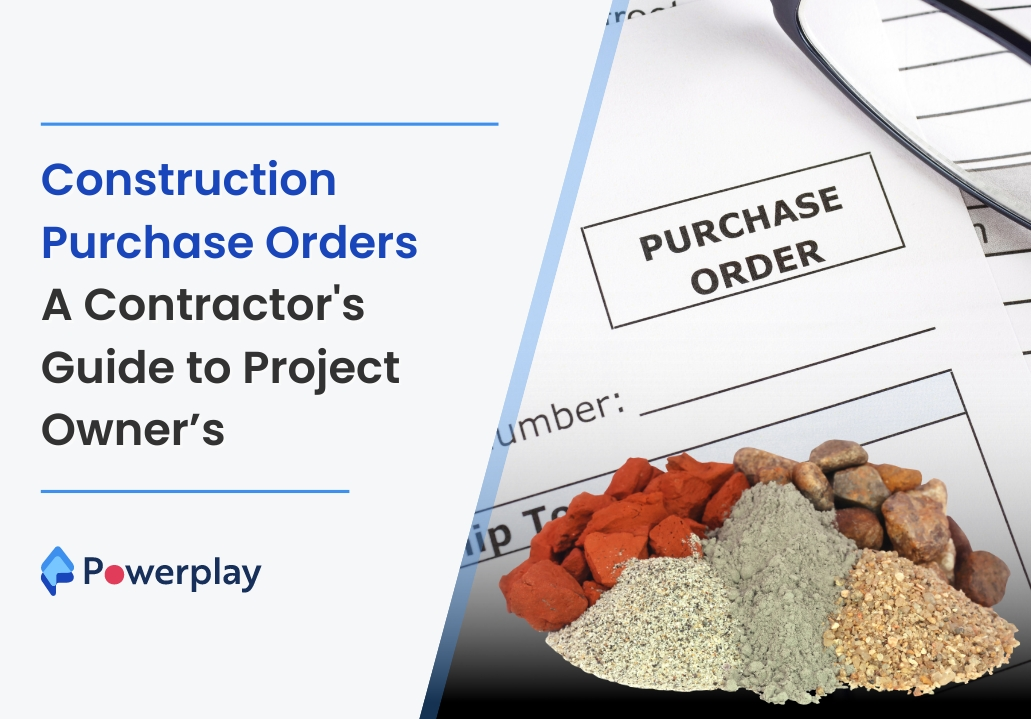
A construction purchase order is an essential legal instrument in the construction industry. It works as a contract between the buyer and the seller and outlines the terms under which goods and services are purchased for a project, ensuring clarity and commitment from both parties.
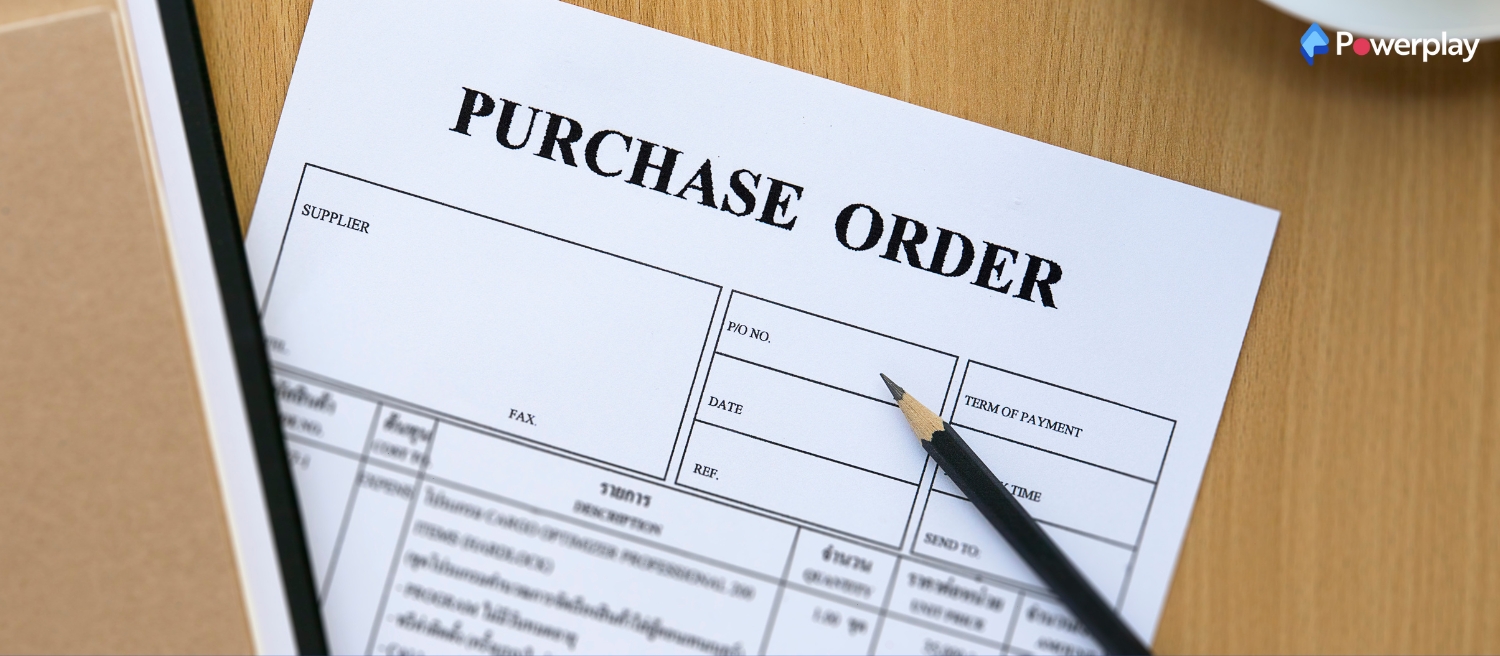
However, contractors often face challenges in managing purchase orders efficiently. They face various issues with purchasing department like miscommunications, delayed deliveries, and discrepancies in quantities or costs, which lead to project delays, cost overruns, and strained relationships between project owners and contractors. Furthermore, with the construction industry’s increasing complexity and the rising costs of materials and labour, the importance of accurate and timely purchase orders has never been greater.
So, in this blog, we have provided a complete guide on how you can effectively manage construction purchase orders to contribute to the overall success of your construction projects.
Table of Contents
What is a Construction Purchase Order?
A construction purchase order is a formal document issued by a construction company or project manager to a supplier or vendor, specifying the types and quantities of materials, equipment, or services needed for a construction project.
This document serves as an official request for the purchase and outlines the details of the items, including descriptions, prices, delivery dates, and payment terms. Once accepted by the supplier, it acts as legally binding documents of agreement, ensuring that both parties clearly understand the terms and expectations of the transaction.
When is a Construction Purchase Order Required?
A construction purchase order is required in several scenarios during a construction project:
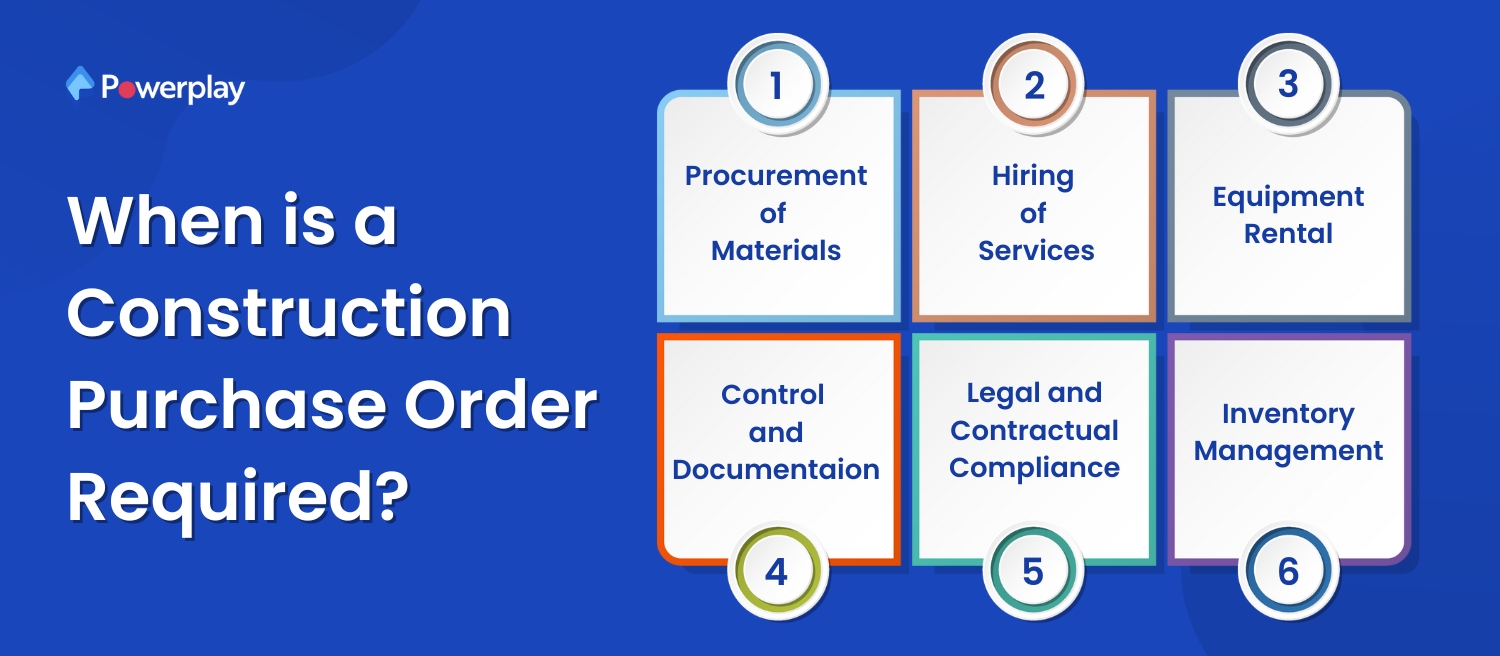
- Procurement of Materials: When specific materials, such as lumber, steel, concrete, or fixtures, are needed for the project, a purchase order formalises the request and purchase from suppliers.
- Hiring of Services: For specialised services like electrical work, plumbing, or architectural design, a purchase order specifies the scope of work, duration, and payment terms.
- Equipment Rental: If the project requires renting machinery or equipment (e.g., cranes, excavators), a purchase order details the rental period, rates, and other conditions.
- Control and Documentation: Purchase orders help track expenditures against the budget and provide a clear record for accounting and auditing purposes.
- Legal and Contractual Compliance: Purchase orders are evidence of agreed-upon terms and conditions, ensuring that purchases comply with project contracts and legal requirements.
- Inventory Management: Purchase orders help manage project inventory by ensuring timely ordering and delivery of necessary items, avoiding delays and cost overruns.
What to Include in a Construction Purchase Order?
Creating an effective construction purchase order requires balancing simplicity and detail to reduce the risk of miscommunication. Once accepted by the supplier, this document forms a legally binding agreement, emphasising the need for accuracy and thoroughness to prevent discrepancies.
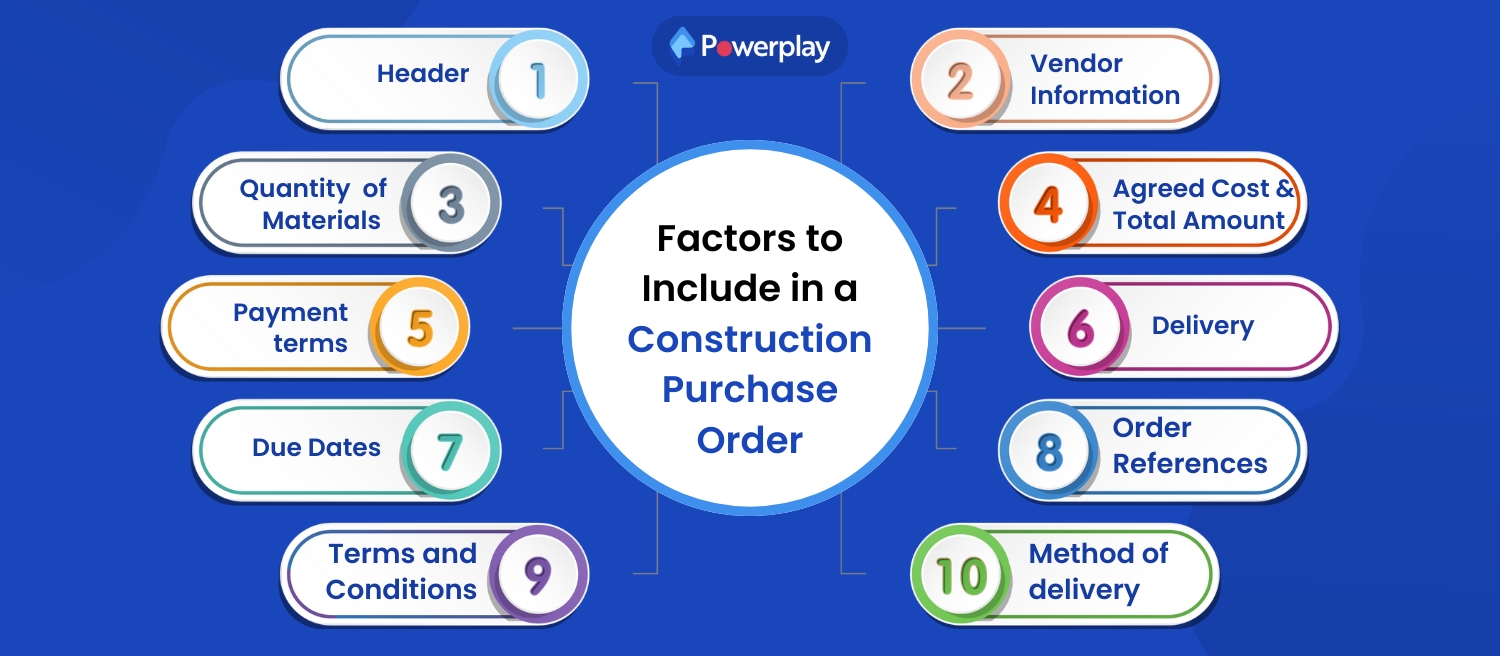
Header
This includes critical details such as the names of the buying and selling parties, the reference number or numbers, and project IDs. It sets the foundation for tracking the order and is essential for procurement and project management.
Vendor Information
Detail the vendor’s name, contact information, and other relevant details to ensure clear communication and accountability between the two parties involved.
Quantity and Description of Materials
List all required materials, equipment, and labour with accurate quantities and detailed descriptions. This helps ensure that the project manager and subcontractor are aligned and the subcontractor gets payement for all the materials required to complete the job.
Agreed Cost & Total Amount
Outline the cost-per-deliverable and any applicable discounts. This section should clarify the itemised costs for transparency and effective budget management.
Payment terms
Describe the payment conditions, often on credit, and specify the net payment period, like ‘net 30 days’, to define the maximum time the buyer has to pay after receiving an invoice.
Delivery
State the delivery method, such as FOB Shipping Point or Destination, and clarify who is responsible for losses or damages during transit.
Due Dates
Include critical dates for the delivery of materials to ensure timely project progression and avoid delays.
Order References & Reference numbers
Use unique reference numbers for each PO to facilitate tracking and management, especially in large projects with multiple POs.
Terms and Conditions
To protect involved parties and ensure clarity on expectations, add any additional terms, warranties, or special instructions that apply to the purchase.
Method of delivery
To ensure the right materials arrive suitably for the project, detail how the items will be delivered, including the anticipated date and any conditions related to the delivery method.
Why are purchase orders important?
Purchase orders are crucial in managing and controlling business transactions. They formally record a buyer’s intent to purchase specific goods or services, outlining quantities, prices, and specifications.
This clarity helps prevent misunderstandings and ensures both parties agree on terms before any money changes hands or work begins. Additionally, purchase orders facilitate budget tracking and financial planning by documenting commitments. They also serve as a key tool for auditing and legal protection, offering a trail of evidence in case of disputes. Essentially, purchase orders help streamline operations and maintain orderly, accountable business practices.
What’s the difference between a purchase order and a contract?
A purchase order and a contract are different processes for business transactions, especially construction. Here are the key differences between a purchase order process and a contract:
| Aspect | Purchase Order | Contract |
| Nature | A document that specifies the intent to purchase specific items or services, detailing quantities, prices, and delivery terms. It becomes legally binding upon acceptance by the seller. | A comprehensive legal agreement outlines a project’s entire scope, including goods, services, prices, payment schedules, and responsibilities of all parties involved. |
| Scope | Focuses on individual transactions for specific goods or services. It details what is being bought, in what quantity, and at what price for a single purchase. | Covers the entire duration and details of a project, including all goods and services to be provided, along with detailed terms and conditions for the whole of the agreement. |
| Legal Binding | Becomes legally binding when accepted by the seller. Initially, it’s an offer that can be rejected or negotiated. | It is legally binding from the moment it is signed by all parties involved. It’s a mutual agreement that cannot be altered without consent from all parties. |
| Duration | Typically, it is short-term and focused on the immediate delivery of goods or services. Once fulfilled, its role is completed. | Long-term, spanning the entire length of the project, which can be weeks, months, or even years, depending on the complexity and scale of the project. |
| Detail Level | It is generally less detailed, concentrating on the specifics of the items or services being purchased, including price and delivery. | Highly detailed, covering all aspects of the project, including dispute resolution, modifications, and specific legal protections for all parties. |
What’s the difference between a purchase order and an invoice?
Here are the key differences between a purchase order and an invoice:
| Aspect | Purchase Order | Invoice |
| Purpose | A document issued by a buyer to a seller indicating types, quantities, and agreed prices for products or services. It initiates the buying process. | A document the seller sends to the buyer requesting payment for goods or services delivered concludes the sales process. |
| Timing | Sent before any goods or services is deliver to establish the details of the intended purchase. | Sent after goods or services is deliver to request payment based on the terms of the initial agreement. |
| Content | Contains descriptions of the desired goods or services, quantities, agreed prices, and delivery terms. | A summary of goods or services provided, quantities, prices, payment terms, and total amount due. |
| Legal Status | It becomes legally binding once accepted by the seller but starts as a proposal from the buyer. | It serves as a demand for payment and can be used as a legal document in financial and tax records. |
| Primary Role | To clarify and confirm the buyer’s intentions and to lock in terms and conditions before fulfilment. | This is to ensure accurate accounting and to facilitate the payment process after the fulfilment of the order. |
Is a Purchase Order a Contract?
A purchase order in construction is not inherently a contract but can evolve into a legally binding agreement once the supplier accepts it. This document outlines the intention to acquire specific construction materials or services, detailing quantities and expected prices.
In contrast, a contract encompasses a comprehensive agreement for a construction project, covering all aspects, including products, negotiated prices, payment schedules, and overall terms and conditions. While a purchase order focuses on individual transactions, a contract binds the entire scope of the project, incorporating all related purchase orders and invoices under its framework. The purchase order is a component within the broader contract structure.
Is a Purchase Order an Invoice?
A purchase order and an invoice are distinct documents in construction. Where as a buyer issues a purchase order to the seller to set the stage for a contract detailing the desired construction materials or services and expected costs.
This step occurs before any work starts. On the other hand, after the work is completed or at agreed milestones, typically the project owner or seller issues an invoice to request payment. Essentially, the purchase order is like a formal “shopping list” sent in anticipation, while the invoice is a “bill” that comes after the job is done, confirming the work and requesting payment.
How Powerplay can help in Construction Purchase Orders?

Powerplay offers robust features that can significantly enhance construction purchase orders’ management and streamline the procurement process. With Powerplay, you can create and manage purchase orders efficiently, ensuring that all necessary materials and service order is correctly and on time. The software also supports the generation and management of Good Received Notes (GRNs), which are crucial for verifying and documenting the receipt of goods.
Here’s how Powerplay can help you manage your construction purchase orders:
Purchase Orders Management: Powerplay enables you to seamlessly generate, track, and manage purchase orders. You can easily create detailed purchase orders specifying materials, quantities, prices, delivery dates and addresses. This feature helps maintain accurate records and ensures your procurement aligns with project requirements and budgets.
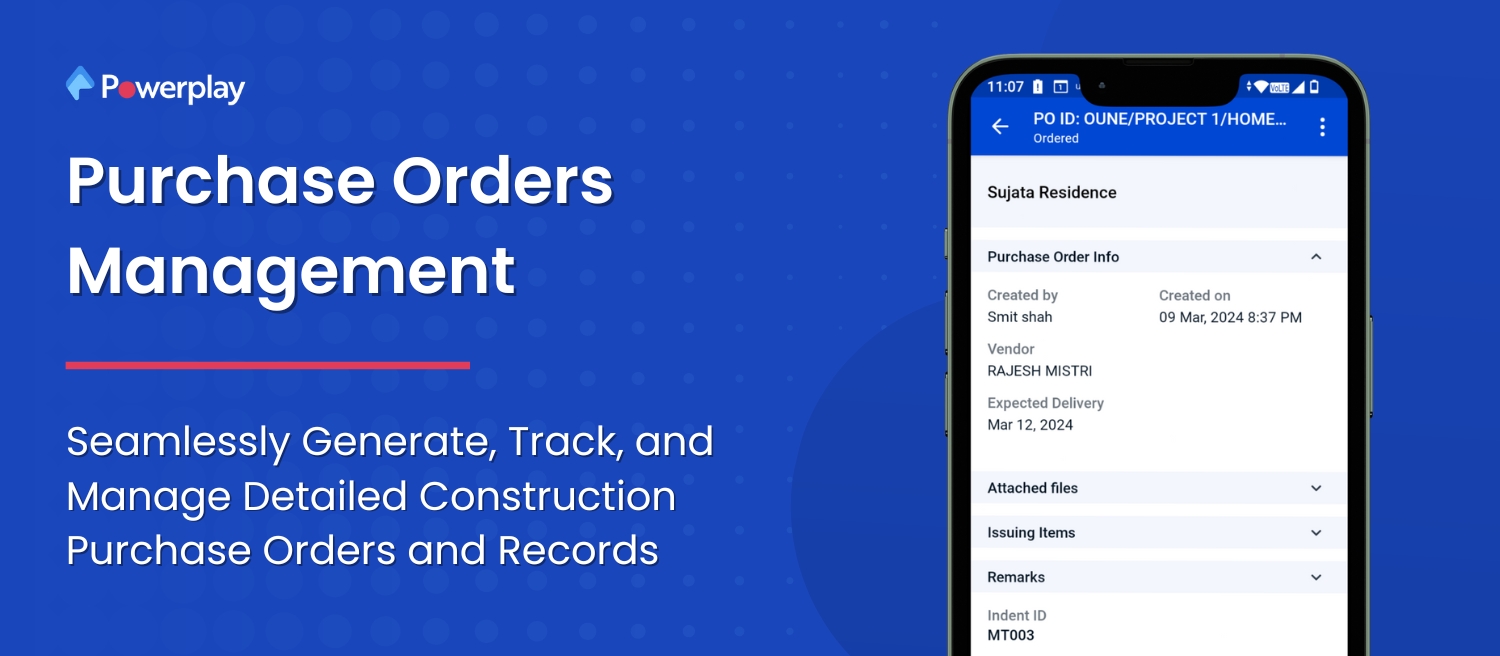
Good Received Notes (GRNs): Powerplay facilitates the creation of GRNs upon receiving materials. These notes are essential for confirming that the delivered goods match the purchase orders in quantity and quality. This verification helps in maintaining accurate inventory levels and ensures that any discrepancies address promptly.
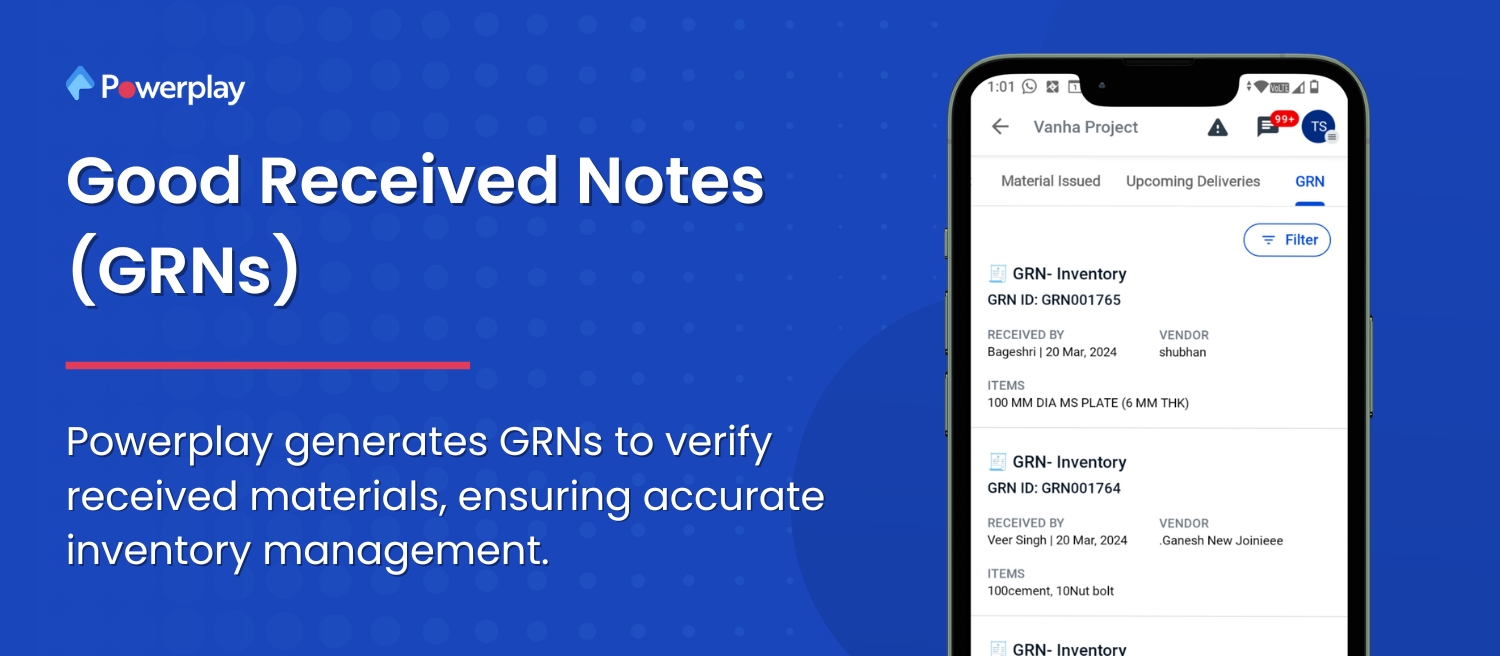
Conclusion
Proper management of construction purchase orders is vital for the success of any construction project. Accurately executing and providing a clear framework for transactions will help prevent misunderstandings and ensure the timely delivery of materials and services.
Managing these orders efficiently will be a cornerstone of successful construction project management, as the construction industry evolves and costs fluctuate. Integrating digital solutions in managing purchase orders will be a key trend, as it offers predictive insights and enhances efficiency across the construction domain. With software like Powerplay, contractors can streamline this process and ensure better control over costs and schedules, paving the way for a smooth construction journey.













